The past Sumenep, Madura birth stories are quite interesting listening to. One of them is on the plate which reputedly has the magic is second to none.
Sumenep plate royal heritage in the reign of Sultan Abdurrahman who ruled from 1811-1854 are able to make food that was served was not stale even to a week.
Oval-shaped plate was able to preserve food or rice that was served for 1 week without any preservatives drug. In fact, rice is said to be able to keep warm in a long time.
Heritage that is currently stored in Sumenep Palace Museum, was a gift of King Sampang, Condro Negoro around 1830. Photos Sampang and year of the king is still clearly visible in the middle of the plate magic.
One of the Palace Museum guide Sumenep, Moh Ramli said the majority of museum visitors marvel at the existence of things remains the king.
"All kinds of things here still contains the power of the unseen," said Ramli told reporters at the two museum buildings Sumenep Palace, Jalan Dr Soetomo No. 6.
He explained, plate dishes such relics of the king had magical abilities tested by the 'smart people'. "Apparently, the food is left in place for 1 week was not stale. This is in accordance with the existing story. Due to the past, the king Sumenep like rice that is still fresh and warm," he said.
Detiksurabaya.com monitoring, the food dish placed in the room or office buildings 2 Koning (king's office) past. For security reasons, the plates are stored neatly in a small glass cabinet, so that visitors can not touch directly on the goods.
Sare Park, Swimming Water that is believed Make it easy love match
The story of the palace Sumenep not inexhaustible. One of the places in the palace which is believed to have magical powers is a bathing pool lady's maid and the wife of the king. The pool water is called the Garden is believed to have magical powers Sare.
The pool is located east of the Great Hall is believed to increase the aura of beauty and quickly get a mate. Also believed to be a medicine to cure the disease if the water was drunk.
"In addition to there face wash that carries water with water bottles menggunaakan meneral. Also believed to increase the aura of beauty as well as for drugs," said Tour Guide, Ramli in discussion with detiksurabaya.com in Sumenep Palace Museum, Jalan Dr Soetomo.
That said, the beauty of the daughter of the famous palace to palace of Majapahit Sumenep. "That's thanks to the water in the Garden of Sare," he said.
But Ramli said, the strength of the water park just a form of God's greatness Sare shown in humans to be closer to Him. "This form of the greatness of God," he said.
However, when this visitor banned bathing in the Garden of Sare. Condition Sare Park, still looks beautiful and cool. The water was clear and there are ornamental fish in large quantities. No doubt if the visitor feel at home when there in the Garden of Sare.
The Great Mosque
Diposting oleh
black-white
di
14.25
Sumenep Great Mosque is listed in the center of the city. It is stayed in front of Taman Adipura (Adipura Park). It is one of the oldest of the ten mosques in Indonesia. The influence of Islamic, China and Europe style make this building unique and interested, these can be seen on its beautiful and unique gate.
The Mosque was built by Tumenggung Arya Noto Kusumo I who known as Panembahan Sumolo in the year of 1763. The society around always take care the Mosque well.
The visitors always complete their journey to Sumenep with visit this unique Mosque.
The Mosque was built by Tumenggung Arya Noto Kusumo I who known as Panembahan Sumolo in the year of 1763. The society around always take care the Mosque well.
The visitors always complete their journey to Sumenep with visit this unique Mosque.
Lombang beach
Diposting oleh
black-white
di
14.24
About 30 km in northwest side of Sumenep, there is a beautiful Lombang beach. It is located in Lombang village, Batang – Batang district. There are many spruce fir farmers that sell their spruce fir bonsai trees. Obviously, Lombang beach bordered by thousands of natural spruce fir (casuarinas) that make the beach feels fresh. This Casuarinas Equisetifolia (Cemara Udang) is naturally growth along Lombang beach and it is very famous in the world, because Casuarinas Equisetifolia can live only in Indonesia and China, so that it feels calm and comfortable.
Lombang beach is interesting tourism object to be promoted to all Indonesia area, even to the world. The position of Lombang beach in south sea of Java Island can facilitated the visitors to see the beautiful sunrise. The other facility around Lombang beach is foods and beverage merchants, such as; Rujak and young coconut ice. The beach is very clean and has clear water with interesting small heap of white sand.
Today, there it had built a transportation facility that connects Lombang beach and Slopeng beach with lime mountain scenery. To reach Lombang beach using public transportation from Bangkal bus station (Sumanep) to Legung village (Batang-Batang). From Legung village, continue to Lombang beach, about 5 km by becak (pedicab). If you using your car through Sumenep – Lombang, you can reach about 30 minutes, through:
1. Sumenep - Gapura - Batang Batang - Legung - Lombang
2. Sumenep - Gapura - Batang-batang - Candi - Lombang
3. Sumenep - Gapura - Longos - Candi - Batang-batang
This Lombang beach tourism object will crowd and splendor in people party or public festival that held a week before Feast holiday.
Lombang beach is interesting tourism object to be promoted to all Indonesia area, even to the world. The position of Lombang beach in south sea of Java Island can facilitated the visitors to see the beautiful sunrise. The other facility around Lombang beach is foods and beverage merchants, such as; Rujak and young coconut ice. The beach is very clean and has clear water with interesting small heap of white sand.
Today, there it had built a transportation facility that connects Lombang beach and Slopeng beach with lime mountain scenery. To reach Lombang beach using public transportation from Bangkal bus station (Sumanep) to Legung village (Batang-Batang). From Legung village, continue to Lombang beach, about 5 km by becak (pedicab). If you using your car through Sumenep – Lombang, you can reach about 30 minutes, through:
1. Sumenep - Gapura - Batang Batang - Legung - Lombang
2. Sumenep - Gapura - Batang-batang - Candi - Lombang
3. Sumenep - Gapura - Longos - Candi - Batang-batang
This Lombang beach tourism object will crowd and splendor in people party or public festival that held a week before Feast holiday.
Traditional Art
Diposting oleh
black-white
di
14.24
KERIS
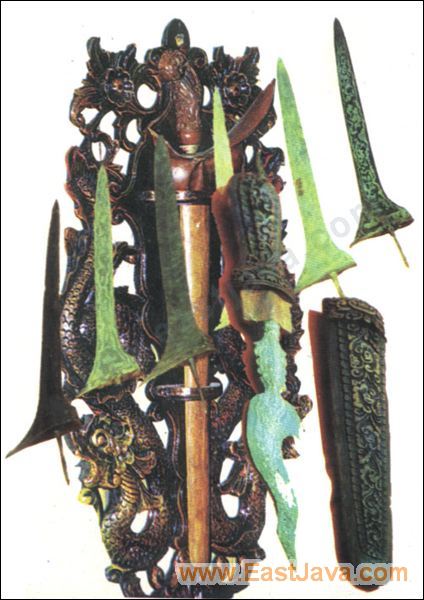 At Saronggi district there is a home industry of making Keris (a wavy double bledded dagger). This home industry is in Aengtongtong village, about three kilometers to the west and two kilometers to the north. Keris is a kind of dagger believe to have magic power. Therefore, in the last time, not all people could make Keris except a man called Mpu (Master Keris Maker). It is now regarded as usual dagger but because its form is unique and interesting, many people have impressed to Keris.
At Saronggi district there is a home industry of making Keris (a wavy double bledded dagger). This home industry is in Aengtongtong village, about three kilometers to the west and two kilometers to the north. Keris is a kind of dagger believe to have magic power. Therefore, in the last time, not all people could make Keris except a man called Mpu (Master Keris Maker). It is now regarded as usual dagger but because its form is unique and interesting, many people have impressed to Keris.
 At Saronggi district there is a home industry of making Keris (a wavy double bledded dagger). This home industry is in Aengtongtong village, about three kilometers to the west and two kilometers to the north. Keris is a kind of dagger believe to have magic power. Therefore, in the last time, not all people could make Keris except a man called Mpu (Master Keris Maker). It is now regarded as usual dagger but because its form is unique and interesting, many people have impressed to Keris.
At Saronggi district there is a home industry of making Keris (a wavy double bledded dagger). This home industry is in Aengtongtong village, about three kilometers to the west and two kilometers to the north. Keris is a kind of dagger believe to have magic power. Therefore, in the last time, not all people could make Keris except a man called Mpu (Master Keris Maker). It is now regarded as usual dagger but because its form is unique and interesting, many people have impressed to Keris.The Aengtongtong Keris product has been sold to the big cities in Indonesia like Surabaya and Jakarta. It has also been sold to other countries, such as; Malaysia, Singapore and Holland.
NYADAR TRADITIONAL CEREMONY
Besides visiting Aengtongtong village to see Keris home industry, one can also go to see Nyadar Traditional Ceremony in Kebundadap village, Saronggi district. It is a traditional ceremony held to celebrate the villager's ancestor named "ANGGOSUTO". He has been regarded as a man who firstly found the way of producing salt through traditionally way. He tought the villagers how to process the sea water to be salt. Because of his merit the villagers always memorize him by helding ceremony called "NYADAR".
Besides visiting Aengtongtong village to see Keris home industry, one can also go to see Nyadar Traditional Ceremony in Kebundadap village, Saronggi district. It is a traditional ceremony held to celebrate the villager's ancestor named "ANGGOSUTO". He has been regarded as a man who firstly found the way of producing salt through traditionally way. He tought the villagers how to process the sea water to be salt. Because of his merit the villagers always memorize him by helding ceremony called "NYADAR".
BATIK
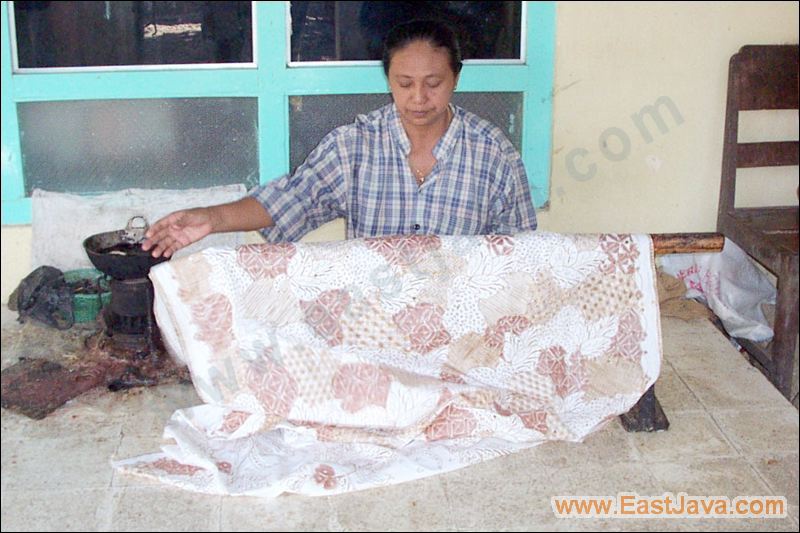 Madura is also popular of its Batik. One of Batik home industries in Madura is Batik " Melati " from Pekandangan Barat - Bluto sub-district Sumenep Regency. Pekandangan Barat is a center of Batik Home Industry located about 10 kilometers north of Sumenep. It is easy to reach for it is sited about 100 meters from the road on the way to Pamekasan regency.
Madura is also popular of its Batik. One of Batik home industries in Madura is Batik " Melati " from Pekandangan Barat - Bluto sub-district Sumenep Regency. Pekandangan Barat is a center of Batik Home Industry located about 10 kilometers north of Sumenep. It is easy to reach for it is sited about 100 meters from the road on the way to Pamekasan regency.
 Madura is also popular of its Batik. One of Batik home industries in Madura is Batik " Melati " from Pekandangan Barat - Bluto sub-district Sumenep Regency. Pekandangan Barat is a center of Batik Home Industry located about 10 kilometers north of Sumenep. It is easy to reach for it is sited about 100 meters from the road on the way to Pamekasan regency.
Madura is also popular of its Batik. One of Batik home industries in Madura is Batik " Melati " from Pekandangan Barat - Bluto sub-district Sumenep Regency. Pekandangan Barat is a center of Batik Home Industry located about 10 kilometers north of Sumenep. It is easy to reach for it is sited about 100 meters from the road on the way to Pamekasan regency.Madura batik has different characteristic to Java's especially its colour. Madura Batik has usually a clear and strong colour like red, green and yellow with bird, flower and dragon as the motif.
Woodcarving Home Industry
 Pragaan district is about 25 kilometers north from Sumenep town. Here one can find the center of wood carving. It is also a home industry that produced by Karduluk villagers.
Pragaan district is about 25 kilometers north from Sumenep town. Here one can find the center of wood carving. It is also a home industry that produced by Karduluk villagers.
 Pragaan district is about 25 kilometers north from Sumenep town. Here one can find the center of wood carving. It is also a home industry that produced by Karduluk villagers.
Pragaan district is about 25 kilometers north from Sumenep town. Here one can find the center of wood carving. It is also a home industry that produced by Karduluk villagers.Karduluk wood carving has a unique style and different colour if compared to Java's. Its colour is clear and strong like red and green, and it often describes bird, flower and dragon as the motif. Its style and colour reflected the influence of China culture.
MUANGSANGKAL DANCE
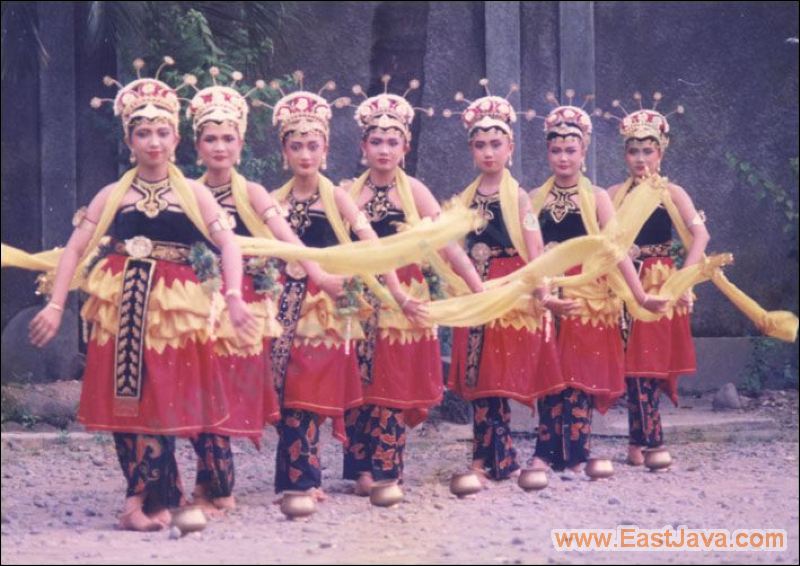 A special dance performed to welcome the guest. Muangsangkal derived from the two words " Muang and Sangkal ". Muang means throw away and Sangkal means unluckiness. This dance depicts the hope of Sumenep people in order they are avoided from disaster. Muangsangkal dance is always played by odd people, it can be five, seven or nine. The traditional costum with strong color like red, yellow and black show its Sumenep characteristict.
A special dance performed to welcome the guest. Muangsangkal derived from the two words " Muang and Sangkal ". Muang means throw away and Sangkal means unluckiness. This dance depicts the hope of Sumenep people in order they are avoided from disaster. Muangsangkal dance is always played by odd people, it can be five, seven or nine. The traditional costum with strong color like red, yellow and black show its Sumenep characteristict.
 A special dance performed to welcome the guest. Muangsangkal derived from the two words " Muang and Sangkal ". Muang means throw away and Sangkal means unluckiness. This dance depicts the hope of Sumenep people in order they are avoided from disaster. Muangsangkal dance is always played by odd people, it can be five, seven or nine. The traditional costum with strong color like red, yellow and black show its Sumenep characteristict.
A special dance performed to welcome the guest. Muangsangkal derived from the two words " Muang and Sangkal ". Muang means throw away and Sangkal means unluckiness. This dance depicts the hope of Sumenep people in order they are avoided from disaster. Muangsangkal dance is always played by odd people, it can be five, seven or nine. The traditional costum with strong color like red, yellow and black show its Sumenep characteristict. 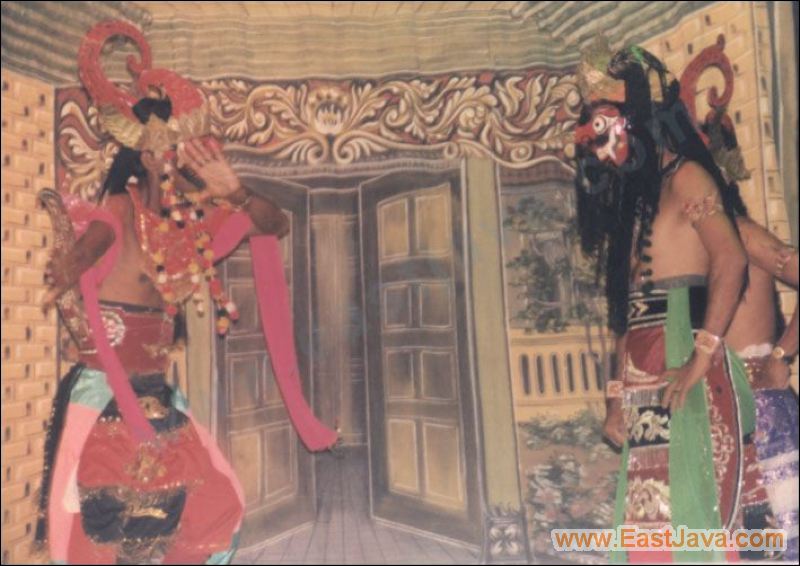 MASK DANCE
MASK DANCEMask dance is a traditional dance played dancers with used mask. It is actually a traditional drama of which story often taken from episode of Mahabharata.
WHIPE DANCE
This dance is usually performed a few minutes before the bullrace competition started to give some opening event to the audience on so that the bullrace competition will be more and more interesting. This dance is played by about 100 dancers consist of boys and girls. The traditional music called Sronen and Thok-thok sounded to go together with this dance.
This dance is usually performed a few minutes before the bullrace competition started to give some opening event to the audience on so that the bullrace competition will be more and more interesting. This dance is played by about 100 dancers consist of boys and girls. The traditional music called Sronen and Thok-thok sounded to go together with this dance.
CODHI' SUMEKAR DANCE
Codhi' is a very small keris usually used as a 'tusuk konde', some accessories of woman hair. In the past time it was also functioned as a dagger to defend from the enemy attack. Codhi' Sumekar dance is played by girl dancers. It describes the power of Sumenep women.
Codhi' is a very small keris usually used as a 'tusuk konde', some accessories of woman hair. In the past time it was also functioned as a dagger to defend from the enemy attack. Codhi' Sumekar dance is played by girl dancers. It describes the power of Sumenep women.
Museum & Keraton Sumenep
Diposting oleh
black-white
di
14.23
One hundred meters eastern of Adipura Park is the location of Museum and Keraton (Palace) Sumenep. The old building on the right side of the road is a place for keeping a gold carriage, a gift from Queen of England to Sumenep King. Beside that, it is also used to keep other inheritance, like; old chairs, old table and the other inheritance.
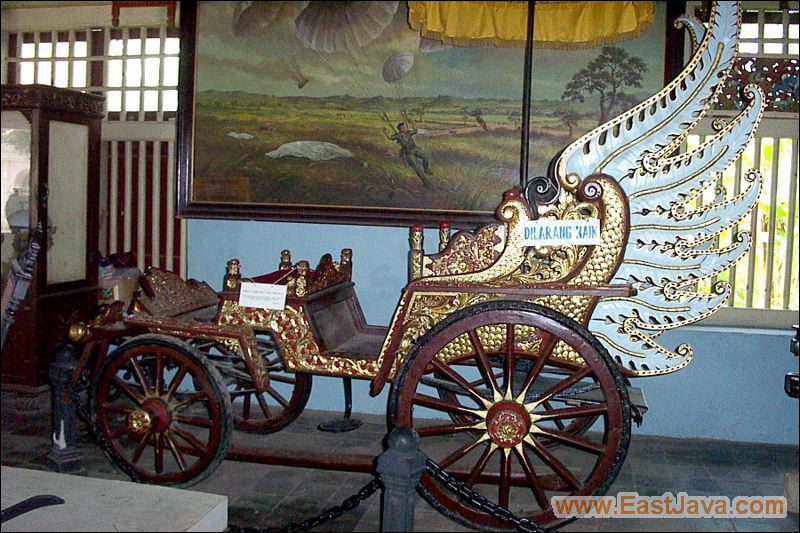 On the right side of the palace there is also an old building named Kantor Koneng. In the last time, it was a palace of Bindoro Saod before he handed to his successor. Now on, it is functioned to keep many kinds of old weapons used in long ago, old traditional ceremony tools, old bracelets and rings of people in the long time and the others. On the back of Kantor Koneng there is a building functioned as museum to. It is used for keep the remnants of Sumenep Royal Palace, the uniform of king, some old chairs and beds, and the new one is a skeleton of hawk found on the Kalianget shore in 1977.
On the right side of the palace there is also an old building named Kantor Koneng. In the last time, it was a palace of Bindoro Saod before he handed to his successor. Now on, it is functioned to keep many kinds of old weapons used in long ago, old traditional ceremony tools, old bracelets and rings of people in the long time and the others. On the back of Kantor Koneng there is a building functioned as museum to. It is used for keep the remnants of Sumenep Royal Palace, the uniform of king, some old chairs and beds, and the new one is a skeleton of hawk found on the Kalianget shore in 1977.
On the left side of Pendopo is Sare Park. It is a park with a small swimming pool of which the water come out from base. In the last time, it was used specially for the princesses.
Sumenep Royal Palace (Keraton) is listed in front of Museum. This palace was built in 1762 in the reign of Tumengung Arya Nata Kusumo I. It consists of Gate, Pendopo, Palace itself, old Palace and Sare Park. The Gate is located in the left side of the palace. It is a great gate with Europe style. It is popular called Labang Mesem (Smiling Gate), an entrance way to the palace complex.
Pendopo ( a meeting hall ) is a hall placed in the center of palace complex used for holding a meeting. It is a simple but unique building completed with beautiful style. The building that related pendopo to the palace called Mandiyoso. It is a building about 25 meters long from the palace to the Pendopo.
Sumenep Palace consist of two floors. The first floor has four rooms. Two of them on the right side and the others on the left. The second floor is a a place for keeping the princesses when they would come to a marriage.
Sumenep Palace consist of two floors. The first floor has four rooms. Two of them on the right side and the others on the left. The second floor is a a place for keeping the princesses when they would come to a marriage.
 On the right side of the palace there is also an old building named Kantor Koneng. In the last time, it was a palace of Bindoro Saod before he handed to his successor. Now on, it is functioned to keep many kinds of old weapons used in long ago, old traditional ceremony tools, old bracelets and rings of people in the long time and the others. On the back of Kantor Koneng there is a building functioned as museum to. It is used for keep the remnants of Sumenep Royal Palace, the uniform of king, some old chairs and beds, and the new one is a skeleton of hawk found on the Kalianget shore in 1977.
On the right side of the palace there is also an old building named Kantor Koneng. In the last time, it was a palace of Bindoro Saod before he handed to his successor. Now on, it is functioned to keep many kinds of old weapons used in long ago, old traditional ceremony tools, old bracelets and rings of people in the long time and the others. On the back of Kantor Koneng there is a building functioned as museum to. It is used for keep the remnants of Sumenep Royal Palace, the uniform of king, some old chairs and beds, and the new one is a skeleton of hawk found on the Kalianget shore in 1977.On the left side of Pendopo is Sare Park. It is a park with a small swimming pool of which the water come out from base. In the last time, it was used specially for the princesses.
SUMENEP MUSEUM
Diposting oleh
black-white
di
14.21
The tiny museum of Sumenep is located in front of the kraton in an old building that was formerly used to store the royal carriages. Now one can find here the historical remnants of the Sumenep kings, like old carriages and furniture.
THE ROYAL CEMETERY “ASTA TINGGI”
The royal cemetery is located 2,5 kilometers northwest of Sumenep City. The construction of this place was started in 1644 AD. To enter the cemetery one goes through some high spectacular gates.
Magic in the Palace Museum Dishes Sumenep
Diposting oleh
black-white
di
14.19
One of the historic relics on display at the Museum Palace Sumenep is magical dish known as 'Magic Power'.
The plate is a magical place of rice-shaped oval, bearing the king Sampang, Condronegoro who ruled in 1830. Rice dishes were given as gifts to the king Sumenep to-32, Sultan Abdurrahman Pakunataningrat (1811-1854).
Palace Museum Guide, Erfandi, Monday (22/11/10) explains, rice dishes rice dishes are not unusual, and is believed to have magical powers of its own. "The proof, according to legend, spread, rice is served on a plate is not stale despite being one week," said Erfandi.
Added rice dishes are usually used for the dish when entertaining guests coming kingdom. "So based on history, because this dish was a special gift from the king Condronegoro, then this is a valuable collection of royal era. honored guests will be treated to a meal on the plate, "said Erfandi.
Currently, rice dishes are on display at the Museum Palace Sumenep, because they have historical value worthy of note that the wider community. "Including the uniqueness and magic of this rice dish. Ya know mbak, right past there has been no 'Magic Jar' as it is now. That there ya'Magic Power 'like this dish," added Erfandi smiling.
The plate is a magical place of rice-shaped oval, bearing the king Sampang, Condronegoro who ruled in 1830. Rice dishes were given as gifts to the king Sumenep to-32, Sultan Abdurrahman Pakunataningrat (1811-1854).
Palace Museum Guide, Erfandi, Monday (22/11/10) explains, rice dishes rice dishes are not unusual, and is believed to have magical powers of its own. "The proof, according to legend, spread, rice is served on a plate is not stale despite being one week," said Erfandi.
Added rice dishes are usually used for the dish when entertaining guests coming kingdom. "So based on history, because this dish was a special gift from the king Condronegoro, then this is a valuable collection of royal era. honored guests will be treated to a meal on the plate, "said Erfandi.
Currently, rice dishes are on display at the Museum Palace Sumenep, because they have historical value worthy of note that the wider community. "Including the uniqueness and magic of this rice dish. Ya know mbak, right past there has been no 'Magic Jar' as it is now. That there ya'Magic Power 'like this dish," added Erfandi smiling.
Langganan:
Postingan (Atom)